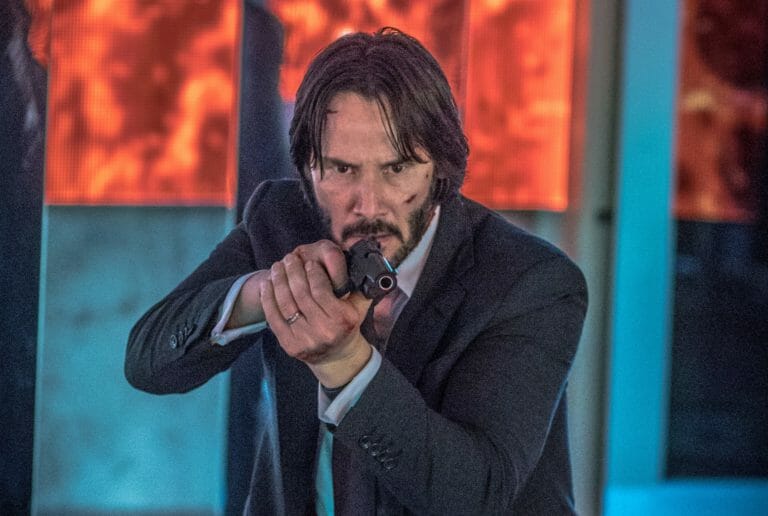Sign up for the
TSL Newsletter
and get $50 off Final Draft 12
By Valerie Kalfrin · February 21, 2017

Keanu Reeves returns as the titular protagonist, a retired hit man who just wants to grieve in peace.
Everything except for Keanu Reeves’s emoting gets kicked up a notch in John Wick: Chapter 2, a sequel to 2014’s surprise action hit about a retired hit man who just wants to grieve in peace. There’s more blood, definitely more head shots (not the modeling kind), more hand-to-hand maneuvers, and surprisingly even more humor, courtesy of the chic and oddly proper underworld introduced in the previous film.
Screenwriter Derek Kolstad and director Chad Stahelski (who goes way back with Reeves, having worked on stunts for both The Matrix and Constantine) both return for the second chapter, picking up roughly where the first film ended.
Those who missed the first film get brought up to speed within the first five to ten minutes as a Russian mobster swigs vodka to calm his nerves about Wick (Reeves), an assassin likened to a boogeyman because of his ability to get the job done through impossible odds. Wick shoots and smashes around the man’s garage to while the mobster bemoans how his idiot nephew brought on this world of hurt by killing Wick’s dog and stealing his car.
Wick retrieves the car, which like that dog, was a gift from his deceased wife, Helen (Bridget Moynihan, shown only in photos and a brief flashback). He returns home to the young pit bull picked up toward the end of the previous movie, but he’s given little time for solace.
Turns out to leave this interconnected underworld when you’re as good at your job as Wick requires a blood promise, a future debt. Wick gave his to Santino D’Antonio (Riccardo Scamarcio) in exchange for his freedom and life with Helen, but with Helen gone, D’Antonio returns for a favor: Kill my sister, so I can take her place in the underworld hierarchy.
Wick declines (“I’m not that guy anymore,” he says), so D’Antonio makes him an offer he can’t refuse, including putting a price on Wick’s head.
Part of the film’s charm is this underworld, first seen in the original film with The Continental, a hotel for assassins where rules say no business is conducted on the premises. Wick returns there reluctantly to satisfy his blood promise. Animal lovers will be glad to see he leaves his dog in the care of the concierge (Lance Reddick), one of many exchanges in this brutal world amusing for their politeness.
But the film doesn’t stop there: The Continental turns out to be part of a worldwide chain, a kind of Ritz-Carlton with a sommelier who recommends a robust AR-15 instead of a ripasso. (Franco Nero, the original 1966 Django, plays the Italian version’s counterpart to the New York branch’s Ian McShane, wondering if Wick’s return this time spells doom for the Pope.) The hotels also connect to an anachronistic communications network of pneumatic tubes, operators routing calls via wired switchboards, and Teletype machines for entering contracts on a person’s life, all of which wind up as texts somehow on modern-day smartphones. Best to smile at that and not think too much.
John Leguizamo and Laurence Fishburne turn up along the way as a mechanic and an underworld figure called the Bowery King (his communication relies on off-the-grid carrier pigeons), while rapper turned actor Common (Suicide Squad) and Ruby Rose (XXX: Return of Xander Cage) go hand-to-hand with Reeves. There’s never any doubt that Wick will outsmart his attackers as the noose tightens, but the enjoyment for action fans is seeing how he uses what’s at his disposal in areas such as a staircase, a subway car, and a mirrored art exhibit. Stahelski wisely shoots the one-on-one moments in medium and wide shots so viewers can follow the action clearly.
Reeves’s Zen-like cool serves him well here. He’s like an athlete resorting to muscle memory, lethal and lightning quick as he automatically falls into what he’s done best. Having seen the originalJohn Wick, where his grief for his wife was palpable, I think that’s a deliberate choice for this film rather than a flaw. (I have a theory that by John Wick: Chapter 3, we’ll see Wick reach the end of his phases of grief.) But those who missed the first film might find him extraordinarily cold.
For action fans, that’s no matter. Just be prepared to wince at some crunching bones and blood spatter as well as laugh where you didn’t expect to do so.